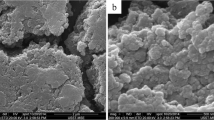Abstract
Much attention has been paid in recent years to the properties of poly acetylene [1] — the archetype conducting polymer having an extended system of conjugated double bonds. Poor chemical stability of polyacetylene against oxygen and humidity lessens however the scope of its possible applications . Other conducting polymers investigated in more detail to date are, among others, polypyrrole [2,3], polythiophene [4], poly-p-phenylene [5] and polyaniline[6,7]. The last named material may be of particular interest since the oxidation of aniline leading to aniline black has been known for many years and only recently the possibility of obtaining linearly conjugated polyanilines was clearly recognized.
Access this chapter
Tax calculation will be finalised at checkout
Purchases are for personal use only
Similar content being viewed by others
References
J.C.W. Chien, Polyacetylene Chemistry, Physics and Material Science, Academic Press 1984
A.F. Diaz, J.I. Castillo, J.A. Logan, W.Y. Lee, J. Electroanal Chem. 129, 115 (1981)
R.E. Myers, J. Electronic Mat. 15, 61 (1986)
T.C. Chung, J.H. Kaufman, A.J. Heeger, F. Wudl, Phys.Rev. B, 30, 702 (1984)
M. Stamm, Mol.Cryst. Liq.Cryst. 105, 259 (1984)
A.G. Green, S. Wolff, Ber. 46, 33 (1913)
A.G. MacDiarmid, J.C. Chiang, W. Huang, B.D. Humphrey, N.L.D. Somasiri, Mol.Cryst.Liq.Cryst. 125, 309 (1985)
V.I. Maltsev, V.A. Itsakovich, Vysokomolekul. Soedin. 5, 1367 (1963)
V.I. Maltsev, V.B. Lebedev, V.A. Itsakovich, A.A. Petrov, Vysokomolekul. Soedin. 4, 848 (1962)
F. Furakawa, T. Hara, Y. Hyodo, I. Harada, Synth. Met. 16, 189 (1986)
G. Cauquis, J. Cognard, D. Serve, Tetrahedron Lett. 48, 4645 (1971)
Author information
Authors and Affiliations
Editor information
Editors and Affiliations
Rights and permissions
Copyright information
© 1987 Springer-Verlag Berlin Heidelberg
About this paper
Cite this paper
Pater, E., Samoc, M., Zuzok, R., Drozdzewskki, P. (1987). Synthesis and Properties of a Conducting Polymer Derived from Diphenylamine. In: Kuzmany, H., Mehring, M., Roth, S. (eds) Electronic Properties of Conjugated Polymers. Springer Series in Solid-State Sciences, vol 76. Springer, Berlin, Heidelberg. https://doi.org/10.1007/978-3-642-83284-0_48
Download citation
DOI: https://doi.org/10.1007/978-3-642-83284-0_48
Publisher Name: Springer, Berlin, Heidelberg
Print ISBN: 978-3-642-83286-4
Online ISBN: 978-3-642-83284-0
eBook Packages: Springer Book Archive




